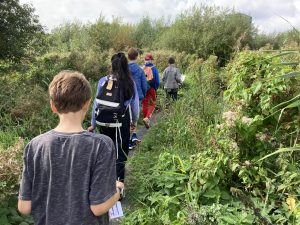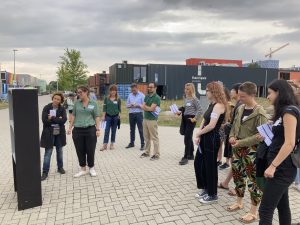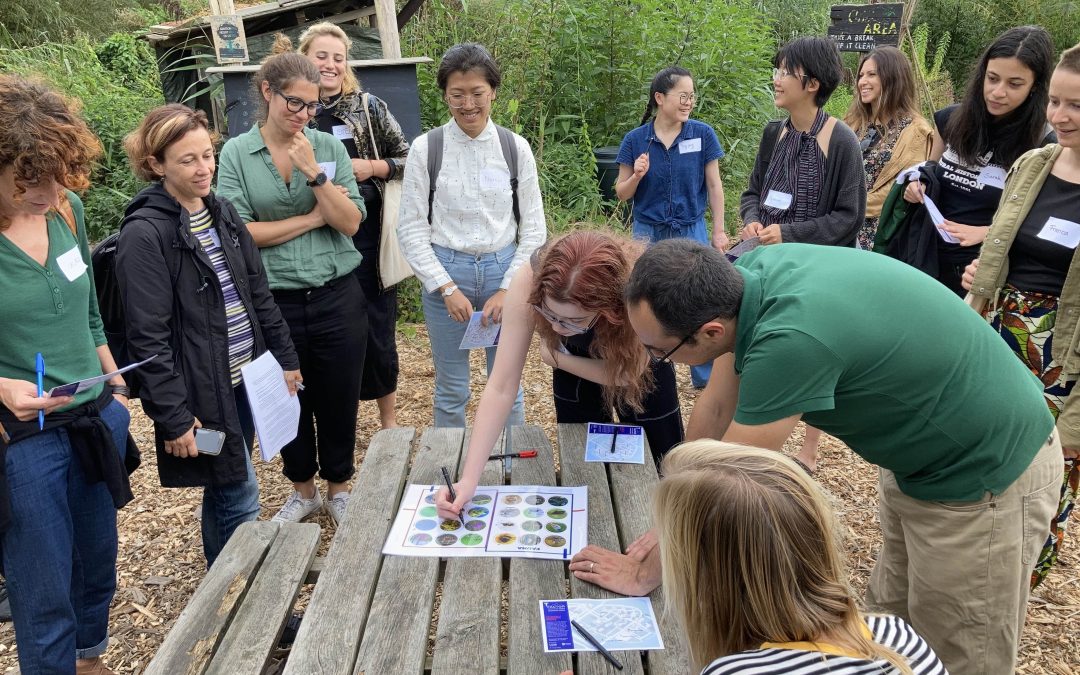How to integrate some sense of wonder in everyday routes? Where we direct attention plays an important role. Last week, I had the pleasure to organise an experiential walk in Amsterdam Science Park (ASP) in collaboration with LAND Research Lab. We were hosted by Waag in the context of the T-Factor project. Our bet was to merge our glances – the biodiversity concerns of landscape architecture and the critical approach to technology in urban landscapes, to provide Amsterdam Science Park dwellers with new lenses to read and appropriate the space. For us, the walk was a way to map emotions and perceptions associated with specific ASP areas. Indeed, the participants’ feedback lays the ground for building future “meanwhile activities”, how in T-Factor we call the variety of ways an area undergoing urban regeneration can be activated between the approval of the masterplan and its final materialisation.
The walk had several stations where participants were guided to experience the Science Park’s biodiversity, space, and infrastructures with tools for heightened perception. In line with Waag’s ecologic agenda for ASP, we focused on natural elements, directing the glance of participants to those (or to noticing their absence).

This was the first experiment for the lab I lead in T-Factor, T-Lab Citizen-led smartness: its focus is architecting meanwhile uses that can question the computational efficiency of the smart city and steer it towards social inclusiveness and sustainability. In the process, we empower inhabitants and dwellers with digital literacy and awareness. In Amsterdam, this was all about exposing tech ubiquity in urban landscapes by mapping meanings and feelings associated with nature and generating a reflection on their value for wellbeing in our highly digitalised society.
There were three entry points for this: the first was giving participants the possibility to detach from their digital devices with a collective entry ritual. It created from station zero a sense of group among strangers and allowed them to be in full presence. The second was the data centre on-site, a glass and steel behemoth surrounded by flowers, which allowed a guided reflection on our digital habits’ materiality and environmental impact. The third was the notion of attention ecology by philosopher Yves Citton. He conceptualises attention as a kind of ecology and invites us to examine how the environments to which we are exposed influence our attention. Inspired by this, participants created their attention ecology of the walk. Finally, as a questioning device, I have built (thank you lockdown, bricolage skills enhancer) a data centre mock-up, a totem that embodied the themes of the walk.

With colleagues from LAND we facilitated 4 walks with different groups, and the feedback was overwhelming positive: professionals working in ASP discovered new places just nearby their regular routes; detaching from tech was described as a luxury experience; understanding the environmental impact of the internet and seeing a data centre in the first person was an eye-opener for some; the permaculture garden was elected as the favourite place; learning to notice the difference between “wild” and “domesticated” green gave some new lenses to look around. We still have a lot material to process!
For T-Lab3, the walk was a way to generate awareness about datafication and ubiquity of tech, while collecting inputs for building meanwhile experiences blending nature, wellbeing and more intentional use of technology. Our challenge ahead in the Amsterdam pilot is to “optimise” wellbeing by reducing traditional technology optimisation practices (e.g. data extraction; connectivity everywhere) and creating restorative areas/experiences where nature and technology minimisation are merged.
